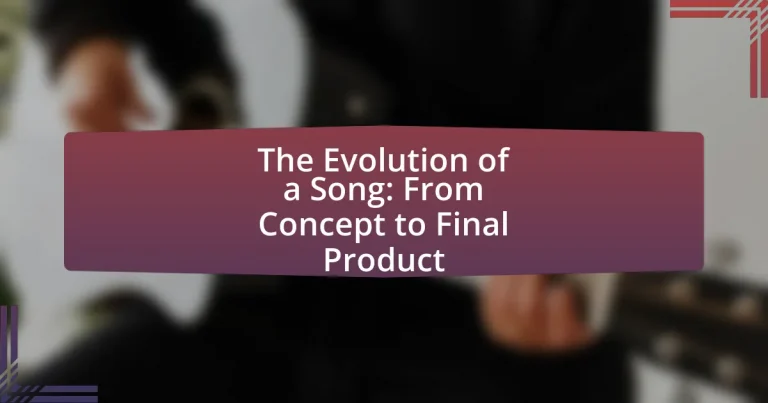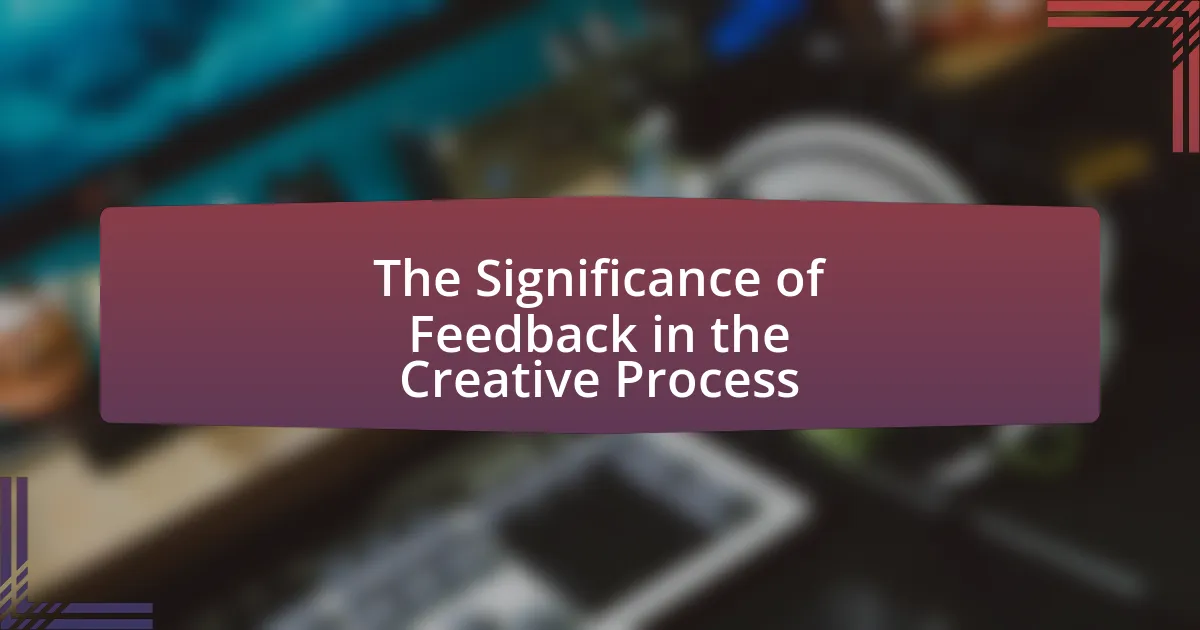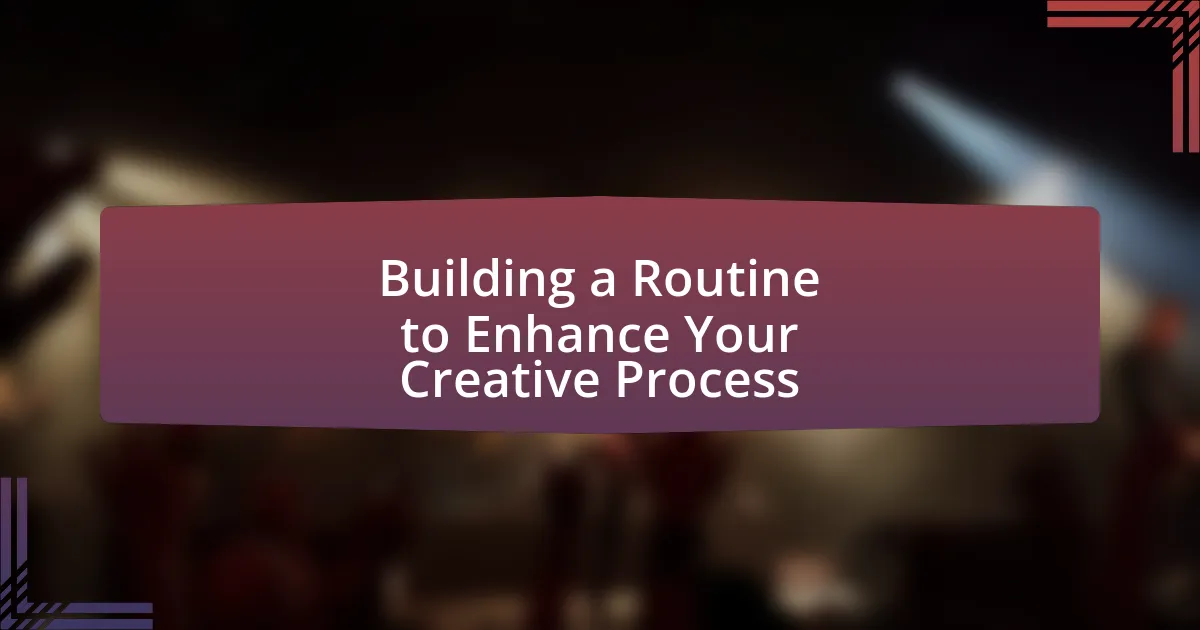The article focuses on the evolution of a song from its initial concept to the final product, detailing the key stages involved: ideation, composition, arrangement, recording, mixing, and mastering. It explores how personal experiences and emotions serve as sources of inspiration for songwriters, influencing the songwriting process and the development of lyrics and melodies. Additionally, the article examines the impact of arrangement and instrumentation on a song’s mood, the role of technology in production, and effective strategies for promoting a newly released song. By outlining best practices and common pitfalls in song production, the article provides a comprehensive overview of the intricate process that transforms a raw idea into a polished musical piece.
What is the process of a song’s evolution from concept to final product?
The process of a song’s evolution from concept to final product involves several key stages: ideation, composition, arrangement, recording, mixing, and mastering. Initially, the ideation stage includes brainstorming themes, lyrics, and melodies, often inspired by personal experiences or emotions. Following this, the composition stage involves writing the song’s structure, including verses, choruses, and bridges, which can be done using instruments or digital software.
Next, the arrangement stage organizes the song’s elements, determining instrumentation and dynamics to enhance the overall sound. The recording stage captures the performance of the song, typically in a studio setting, where vocals and instruments are recorded separately or together. After recording, the mixing stage balances the individual tracks, adjusting levels, panning, and adding effects to create a cohesive sound. Finally, the mastering stage polishes the mixed track, ensuring it meets industry standards for distribution by optimizing sound quality and volume levels.
This structured approach is supported by industry practices, where each stage is crucial for transforming a raw idea into a polished final product ready for release.
How does the initial concept of a song come about?
The initial concept of a song typically arises from a combination of personal experiences, emotions, or ideas that the songwriter wishes to express. Songwriters often draw inspiration from their surroundings, relationships, or societal issues, which serve as the foundation for the song’s theme. For instance, many iconic songs have been inspired by significant life events or cultural movements, demonstrating how external influences shape the creative process. This concept formation is crucial as it sets the direction for the lyrics, melody, and overall structure of the song.
What are the common sources of inspiration for songwriters?
Common sources of inspiration for songwriters include personal experiences, emotions, relationships, and societal issues. Personal experiences often serve as a foundation for songwriting, as artists draw from their own lives to create relatable narratives. Emotions, such as love, heartbreak, and joy, frequently inspire lyrics that resonate with listeners. Relationships, whether romantic or platonic, provide rich material for exploring themes of connection and conflict. Additionally, societal issues, including politics, culture, and social justice, can motivate songwriters to address broader themes and provoke thought. These sources are validated by numerous interviews with songwriters who cite their lived experiences and observations as key influences in their creative processes.
How do personal experiences influence the songwriting process?
Personal experiences significantly shape the songwriting process by providing authentic emotional content and relatable narratives. Songwriters often draw from their own life events, relationships, and feelings, which allows them to create music that resonates deeply with listeners. For instance, a study published in the Journal of Music Therapy found that songwriters who incorporate personal experiences into their lyrics often produce more impactful and emotionally charged songs, enhancing listener engagement. This connection between personal narrative and songwriting not only enriches the creative process but also fosters a sense of authenticity that can lead to greater commercial success.
What are the key stages in the songwriting process?
The key stages in the songwriting process include idea generation, lyric writing, melody composition, arrangement, and revision. Idea generation involves brainstorming themes or concepts for the song. Lyric writing focuses on crafting the words that convey the song’s message. Melody composition is the creation of the tune that accompanies the lyrics. Arrangement involves structuring the song, including instrumentation and dynamics. Finally, revision is the process of refining the song based on feedback and personal evaluation. Each stage is crucial for transforming a concept into a polished final product.
How does brainstorming contribute to song development?
Brainstorming significantly contributes to song development by generating a wide array of ideas and concepts that can be refined into a cohesive piece. This creative process allows songwriters to explore various themes, melodies, and lyrical structures, fostering innovation and collaboration. Research indicates that brainstorming enhances creativity by encouraging free thinking and reducing self-censorship, which can lead to unique musical expressions. For instance, a study published in the Journal of Creative Behavior found that group brainstorming sessions often yield more diverse ideas compared to individual efforts, highlighting the effectiveness of collaborative creativity in songwriting.
What role does collaboration play in songwriting?
Collaboration plays a crucial role in songwriting by enhancing creativity and bringing diverse perspectives to the process. When songwriters work together, they can combine their unique ideas, experiences, and skills, leading to more innovative and compelling songs. Research indicates that collaborative songwriting often results in higher-quality music, as seen in successful partnerships like Lennon-McCartney and the numerous hit songs produced by teams in the music industry. This synergy not only fosters a richer creative environment but also allows for the blending of different musical styles and influences, ultimately enriching the final product.
How is a song structured during its evolution?
A song is structured during its evolution through distinct phases, typically including the initial concept, development of melody and lyrics, arrangement, and final production. Initially, songwriters generate ideas, often starting with a theme or emotion, which serves as the foundation for the song. As the song progresses, melodies and lyrics are crafted, often going through multiple revisions to enhance emotional impact and coherence.
The arrangement phase involves deciding on instrumentation, harmonies, and the overall structure, such as verses, choruses, and bridges, which are essential for creating a dynamic listening experience. Finally, the production phase includes recording, mixing, and mastering, where the song is polished for release. This structured approach is supported by the common practice in the music industry, where songwriters and producers often follow these stages to ensure a cohesive and engaging final product.
What are the typical components of a song’s structure?
The typical components of a song’s structure include verses, choruses, bridges, and sometimes an intro and outro. Verses provide the narrative or thematic content, while choruses deliver the main message or hook, often repeated for emphasis. Bridges serve as a contrasting section that connects different parts of the song, adding variety. An intro sets the stage for the song, and an outro concludes it. This structure is widely recognized in various music genres, demonstrating its effectiveness in engaging listeners and enhancing the overall musical experience.
How do verses, choruses, and bridges interact in a song?
Verses, choruses, and bridges interact in a song by serving distinct yet complementary roles that enhance the overall structure and emotional impact. Verses typically present the narrative or theme, providing context and detail, while choruses deliver the central message or hook, often characterized by repetition for memorability. Bridges serve as transitional sections that create contrast, offering a departure from the established patterns of verses and choruses, which can heighten emotional tension or provide a fresh perspective before returning to the familiar elements. This interplay allows for dynamic storytelling and keeps the listener engaged throughout the song.
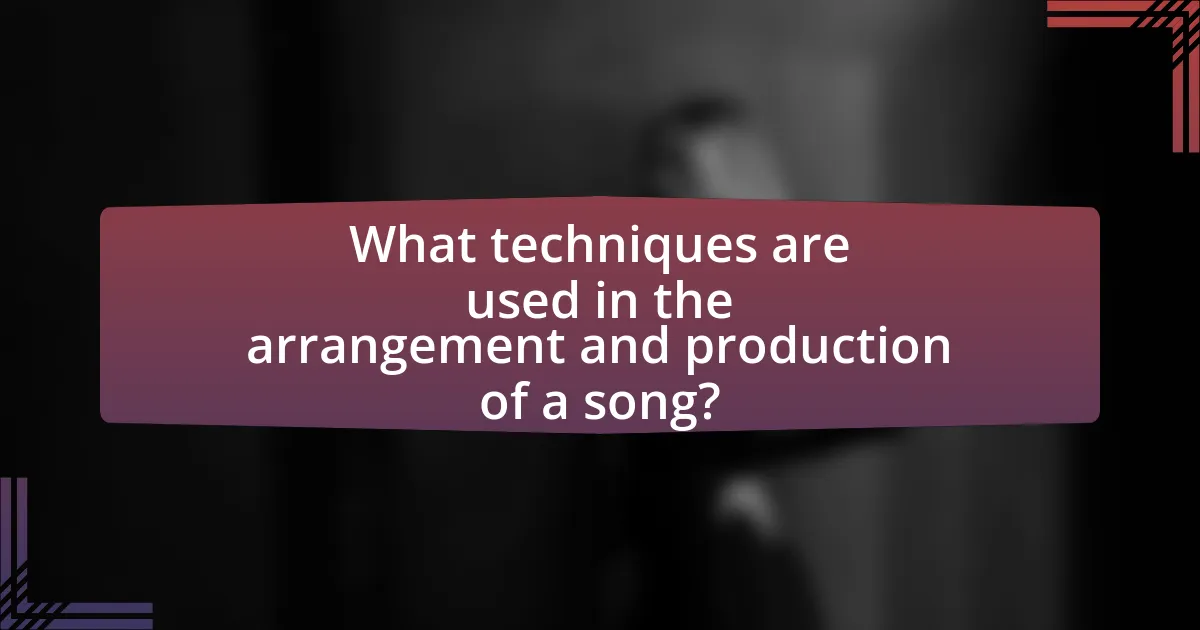
What techniques are used in the arrangement and production of a song?
Techniques used in the arrangement and production of a song include layering, instrumentation, dynamics, and mixing. Layering involves adding multiple tracks of instruments and vocals to create a fuller sound. Instrumentation refers to the selection and arrangement of musical instruments, which can significantly influence the song’s mood and style. Dynamics control the volume and intensity of different sections, enhancing emotional impact. Mixing is the process of balancing all elements, adjusting levels, panning, and applying effects to ensure clarity and cohesion in the final product. These techniques are essential for transforming a basic idea into a polished song, as evidenced by the widespread use of these methods in successful music production across various genres.
How does arrangement impact the overall feel of a song?
Arrangement significantly impacts the overall feel of a song by determining its structure, dynamics, and emotional trajectory. The arrangement dictates how various musical elements, such as melody, harmony, rhythm, and instrumentation, interact throughout the piece. For instance, a sparse arrangement can create a sense of intimacy, while a fuller arrangement can evoke grandeur or excitement. Research shows that specific arrangements can influence listener emotions; for example, a study published in the Journal of Experimental Psychology found that variations in orchestration and dynamics can alter perceived emotional intensity in music. Thus, the arrangement is crucial in shaping how a song is experienced by its audience.
What are the different arrangement styles used in various genres?
Different arrangement styles used in various genres include verse-chorus structure in pop, AABA form in jazz, and through-composed techniques in classical music. Each genre employs distinct arrangements to enhance its musical narrative; for instance, pop music often relies on repetitive hooks to engage listeners, while jazz may utilize improvisation within a structured framework to showcase musicianship. Classical compositions frequently explore thematic development without repeating sections, allowing for a more fluid progression. These arrangement styles are foundational to the identity of their respective genres, influencing how music is created and experienced.
How do instrumentation choices affect a song’s mood?
Instrumentation choices significantly affect a song’s mood by influencing the emotional response of listeners through timbre, dynamics, and arrangement. For example, the use of major chords typically evokes feelings of happiness, while minor chords can create a sense of sadness or tension. Additionally, instruments like strings can convey warmth and intimacy, whereas brass instruments often project power and brightness. Research indicates that specific instrumentation can trigger emotional reactions; a study published in the journal “Psychology of Music” by Gabrielsson and Lindström found that different instrumental combinations can elicit distinct emotional responses in listeners. Thus, the selection of instruments plays a crucial role in shaping the overall mood of a song.
What role does technology play in song production?
Technology plays a crucial role in song production by enabling artists and producers to create, edit, and distribute music more efficiently and creatively. Digital audio workstations (DAWs) allow for multi-track recording, editing, and mixing, which enhances the overall sound quality and production value of songs. Additionally, software plugins and virtual instruments provide a vast array of sounds and effects that can be manipulated to achieve desired artistic outcomes. According to a report by the International Federation of the Phonographic Industry, over 70% of music is now produced using digital technology, highlighting its dominance in the industry. This technological integration not only streamlines the production process but also democratizes music creation, allowing independent artists to produce high-quality music without the need for expensive studio time.
How have digital audio workstations changed music production?
Digital audio workstations (DAWs) have revolutionized music production by enabling musicians and producers to create, edit, and mix music entirely within a software environment. This shift has democratized music production, allowing individuals with limited resources to access professional-grade tools that were once only available in high-end studios. DAWs provide features such as multi-track recording, MIDI sequencing, and a vast array of virtual instruments and effects, which enhance creativity and streamline the production process. According to a 2020 report by the International Federation of the Phonographic Industry, over 70% of music creators now use DAWs, highlighting their central role in modern music production.
What are the benefits of using software plugins in song creation?
Using software plugins in song creation enhances creativity, efficiency, and sound quality. These plugins provide a wide range of virtual instruments, effects, and processing tools that allow musicians to experiment with different sounds and styles without the need for expensive hardware. For instance, plugins can simulate real instruments or create entirely new sounds, enabling unique musical expressions. Additionally, they streamline the production process by offering features like automation, mixing, and mastering tools, which can significantly reduce the time spent on each project. The accessibility of these plugins has democratized music production, allowing both amateur and professional musicians to produce high-quality tracks from home studios.
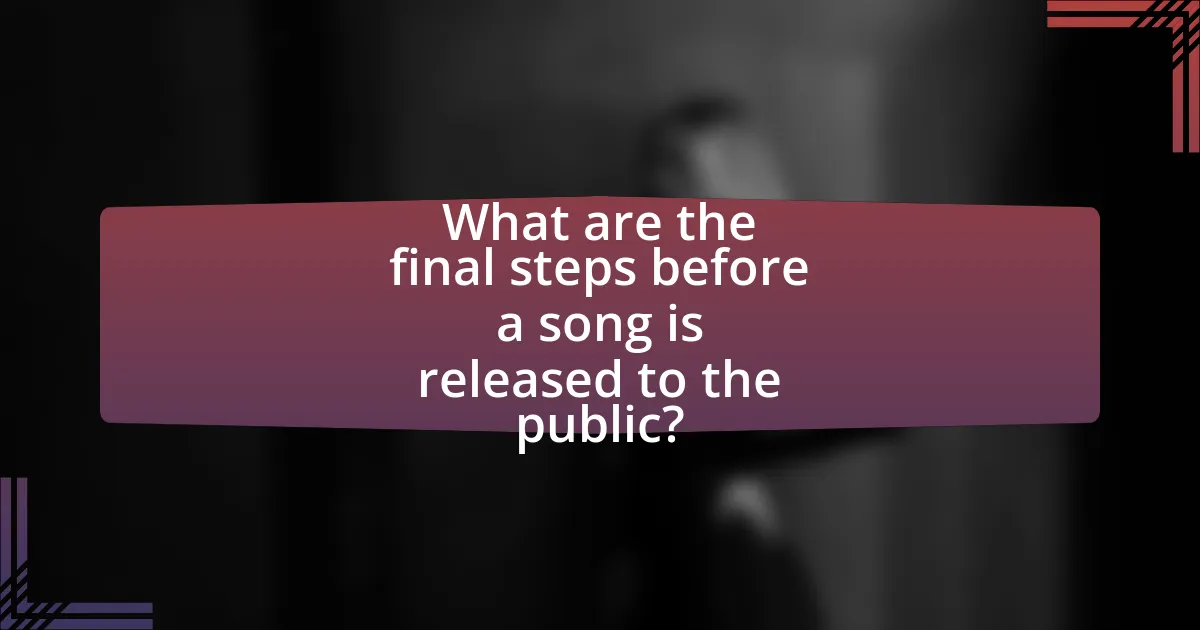
What are the final steps before a song is released to the public?
The final steps before a song is released to the public include mixing, mastering, and distribution. Mixing involves balancing the individual tracks of the song to create a cohesive sound, while mastering is the process of preparing the final mix for distribution by optimizing playback across various formats and platforms. Distribution entails delivering the mastered track to music platforms, ensuring it is available for streaming and purchase. These steps are critical as they enhance the song’s quality and accessibility, ultimately impacting its reception by the audience.
How is mixing different from mastering in the production process?
Mixing and mastering are distinct stages in the music production process. Mixing involves combining individual audio tracks, adjusting levels, panning, and applying effects to create a cohesive sound. This stage focuses on the artistic and technical aspects of balancing elements within a song. In contrast, mastering is the final step that prepares the mixed track for distribution, ensuring it meets industry standards for loudness, clarity, and consistency across various playback systems. Mastering involves equalization, compression, and limiting to enhance the overall sound quality and ensure the track translates well on different formats.
What are the key elements to consider during the mixing stage?
The key elements to consider during the mixing stage include balance, panning, equalization, dynamics, and effects. Balance involves adjusting the levels of each track to ensure clarity and cohesion in the overall sound. Panning refers to the placement of sounds in the stereo field, which helps create a sense of space and dimension. Equalization is used to enhance or reduce specific frequencies, allowing each instrument to occupy its own sonic space. Dynamics control, through compression and limiting, ensures that the mix maintains a consistent volume and prevents distortion. Finally, effects such as reverb and delay add depth and texture to the mix. These elements are essential for achieving a polished and professional sound in the final product.
How does mastering enhance the final sound of a song?
Mastering enhances the final sound of a song by optimizing its overall audio quality and ensuring consistency across playback systems. This process involves adjusting levels, equalization, compression, and limiting to achieve a polished sound that translates well on various devices. For instance, mastering can increase the loudness of a track without sacrificing dynamic range, making it competitive in commercial markets. Additionally, mastering ensures that the tonal balance is appropriate, which is crucial for listener engagement. Studies have shown that professionally mastered tracks are perceived as more polished and enjoyable, leading to higher listener retention rates.
What strategies are effective for promoting a newly released song?
Effective strategies for promoting a newly released song include leveraging social media platforms, engaging with influencers, and utilizing streaming services. Social media platforms like Instagram, TikTok, and Twitter allow artists to connect directly with fans, share behind-the-scenes content, and create viral challenges that can increase visibility. Engaging with influencers who resonate with the target audience can amplify reach, as influencers often have established trust with their followers. Additionally, utilizing streaming services like Spotify and Apple Music for playlist placements can significantly enhance exposure, as songs featured on popular playlists can reach millions of listeners. According to a report by Nielsen Music, songs that are included in curated playlists see a 30% increase in streams, demonstrating the effectiveness of this strategy.
How can social media be utilized for song promotion?
Social media can be utilized for song promotion by leveraging platforms to engage audiences, share content, and create buzz around the release. Artists can post teasers, behind-the-scenes footage, and snippets of the song to generate interest. According to a 2021 report by the International Federation of the Phonographic Industry, 75% of music consumers discover new music through social media platforms, highlighting their effectiveness in reaching potential listeners. Additionally, using targeted ads on platforms like Facebook and Instagram can increase visibility, allowing artists to reach specific demographics that align with their music style.
What role do music videos play in a song’s marketing strategy?
Music videos serve as a crucial component of a song’s marketing strategy by enhancing audience engagement and expanding reach. They visually represent the song’s themes and emotions, making the music more relatable and memorable. According to a study by Nielsen, music videos can increase song sales by up to 50%, demonstrating their effectiveness in driving consumer interest. Additionally, platforms like YouTube provide a vast audience, with billions of views on popular music videos, further amplifying the song’s visibility and potential for viral success.
What best practices should songwriters follow throughout the evolution process?
Songwriters should prioritize collaboration, continuous feedback, and adaptability throughout the evolution process. Collaboration with other musicians and producers can enhance creativity and introduce new perspectives, leading to a more refined final product. Continuous feedback from peers and audiences allows songwriters to identify strengths and weaknesses in their work, facilitating improvements. Adaptability is crucial as it enables songwriters to pivot their ideas based on constructive criticism or changing trends in the music industry. These practices are supported by the success of numerous hit songs that emerged from collaborative efforts and iterative processes, demonstrating their effectiveness in producing high-quality music.
How can songwriters maintain creativity during the writing process?
Songwriters can maintain creativity during the writing process by incorporating diverse techniques such as setting specific goals, experimenting with different musical styles, and collaborating with other artists. Setting clear objectives helps songwriters focus their ideas and provides a framework for creativity. Experimenting with various genres or instruments can inspire new sounds and perspectives, leading to innovative compositions. Collaboration with other musicians or songwriters introduces fresh ideas and approaches, enhancing the creative process. Research indicates that collaboration can significantly boost creativity, as seen in studies like “The Collaborative Nature of Creativity” by Paul Paulus and Bernard Nijstad, which highlights how group dynamics can foster innovative thinking.
What are common pitfalls to avoid in song production?
Common pitfalls to avoid in song production include neglecting pre-production planning, overcomplicating arrangements, and failing to prioritize sound quality. Pre-production planning is essential as it sets the foundation for the entire project; without it, artists may struggle with direction and coherence. Overcomplicating arrangements can lead to cluttered mixes, making it difficult for listeners to engage with the song. Prioritizing sound quality is crucial because poor audio fidelity can undermine the emotional impact of the music. According to a study by the Berklee College of Music, effective pre-production can significantly enhance the final product, demonstrating the importance of these considerations in successful song production.
